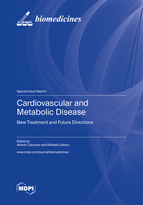Cardiovascular and Metabolic Disease: New Treatment and Future Directions
A special issue of Biomedicines (ISSN 2227-9059). This special issue belongs to the section "Molecular and Translational Medicine".
Deadline for manuscript submissions: closed (15 December 2022) | Viewed by 35541
Special Issue Editors
Interests: cardiovascular (CV) risk; diabetes; heart failure (HF); metformin; diabetes complications
Special Issues, Collections and Topics in MDPI journals
Special Issue Information
Dear Colleagues,
Cardiovascular diseases (CVDs) are the leading cause of death worldwide. In 2019, it has been estimated that 17.9 million people died from CVDs (32% of all global deaths). Of these deaths, 85% were due to heart attack and stroke. These data are usually powered by the coexistence of metabolic diseases, in particular diabetes. In fact, about 422 million people worldwide have diabetes, the majority living in low- and middle-income countries, and 1.5 million deaths are directly attributed to diabetes each year. It is vital to detect CVDs and metabolic disease as early as possible, as most cases can be prevented by addressing behavioral risk factors such as tobacco use, unhealthy diet and obesity, physical inactivity, and harmful use of alcohol. Moreover, we are the main actors and observers of the innovations in every field of CVDs and metabolic disease treatment, from the pharmacological approach, with the advent of sodium glucose cotransporter 2 inhibitors for both heart failure and diabetes, to the improvement of new less-invasive and invasive techniques such as immediate revascularization in both heart and brain infarction and new methods of mechanical cardiac support and multiorgan transplantation for the most advanced forms of heart failure.
Given the complexity of this topic and its impact on clinical practice and public health, Biomedicines is launching a Special Issue entitled “Cardiovascular and Metabolic Disease: New Treatments and Future Directions” with the aim of gathering accurate and up-to-date scientific information on all aspects of new and upcoming treatment opportunities for CVDs and metabolic diseases. It is my privilege to invite you and your co-workers to share their experience and expertise by submitting original research articles, systematic reviews and review articles reporting new ideas and recent advances in this topic.
Dr. Alfredo Caturano
Dr. Raffaele Galiero
Guest Editors
Manuscript Submission Information
Manuscripts should be submitted online at www.mdpi.com by registering and logging in to this website. Once you are registered, click here to go to the submission form. Manuscripts can be submitted until the deadline. All submissions that pass pre-check are peer-reviewed. Accepted papers will be published continuously in the journal (as soon as accepted) and will be listed together on the special issue website. Research articles, review articles as well as short communications are invited. For planned papers, a title and short abstract (about 100 words) can be sent to the Editorial Office for announcement on this website.
Submitted manuscripts should not have been published previously, nor be under consideration for publication elsewhere (except conference proceedings papers). All manuscripts are thoroughly refereed through a single-blind peer-review process. A guide for authors and other relevant information for submission of manuscripts is available on the Instructions for Authors page. Biomedicines is an international peer-reviewed open access monthly journal published by MDPI.
Please visit the Instructions for Authors page before submitting a manuscript. The Article Processing Charge (APC) for publication in this open access journal is 2600 CHF (Swiss Francs). Submitted papers should be well formatted and use good English. Authors may use MDPI's English editing service prior to publication or during author revisions.
Keywords
- cardiovascular disease
- metabolic disease
- diabetes
- therapy
- drugs
- implantable device
- heart failure
- heart transplantation
- cardiac surgery
- future directions







